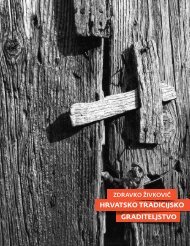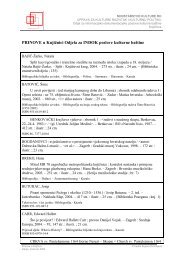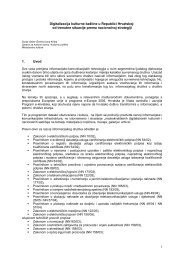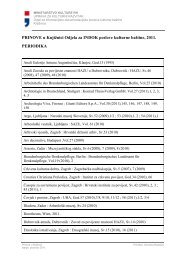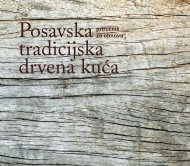Gašpina mlinica u Solinu - Ministarstvo kulture RH
Gašpina mlinica u Solinu - Ministarstvo kulture RH
Gašpina mlinica u Solinu - Ministarstvo kulture RH
Create successful ePaper yourself
Turn your PDF publications into a flip-book with our unique Google optimized e-Paper software.
112 | Godišnjak zaštite spomenika <strong>kulture</strong> Hrvatske 33/34-2009./2010.<br />
Summary<br />
THE BUILDING OF WATERMILLS – A VANISHING<br />
SKILL; GAŠPIN’S WATERMILL IN SOLIN<br />
The Jadro River – Rika has been a life source in the Solin region during<br />
the Illyrian, Greek and Roman periods and the origin of Croatian<br />
Solin. On Rika and its tributaries from ancient times to the end of<br />
the 19th century numerous watermills were built and the milling<br />
industry was an important economic activity during the entire<br />
history of the Solin region.<br />
In the Austrian cadastre land survey of Solin and Klis from 1831, in<br />
the area of the inner centre of the present day city, seven mills with<br />
51 mill wheels were registered: Gašpin’s mill, Aljinović’s mill, the big<br />
Gabrič mill, the small Gabrić mill, Janko’s mill, Big Galija and Small<br />
Galija. In addition to providing income for the millers and owners,<br />
mills were places where the inhabitants of Solin and its surroundings<br />
gathered, playing thereby an important role in the social life<br />
of the community. The abandonment of the traditional way of life<br />
and earning a living transformed the environment of Solin. The only<br />
preserved former mill structures to the present day are Gašpin’s mill,<br />
the Big and Small Gabrić’s mills and the Big Galija where the miller<br />
Marija Grubišić Ponkova worked until the 1980’s. Nevertheless, in<br />
the symbolic sense the mills in Rika still have special meaning for<br />
the citizens of Solin.<br />
Gašpin’ mill is mentioned for the first time in documents from 1711.<br />
In time it was reconstructed and expanded on more than one occasion<br />
and finally structured into a complex of four mutually connected<br />
buildings in a series with fifteen mill mechanisms. The Gašpin’s<br />
26 Obnovljeno mlinsko<br />
postrojenje u južnoj<br />
kući Gašpine mlinice u<br />
jesen 2008. godine (foto:<br />
Sanja Buble, 2008.)<br />
Reconstructed mill<br />
mechanism in the<br />
southern structure of<br />
Gašpin’s mill in autumn<br />
2008 (photo by Sanja<br />
Buble, 2008)<br />
mills belong to the most wide-spread type of Dalmatian mills with<br />
a horizontal mill wheel. The stream of water from the groove falls on<br />
the paddles of the mill wheel so that its horizontal circular movement<br />
over the vertical axis – spindle is directly transmitted to the upper<br />
mill stone. The historical continuity and ethnographic importance of<br />
Gašpin’s watermill are an indication of the economic development<br />
in the Solin area and give Gašpin’s mill a monument value. The reconstruction<br />
of the mill ruins lasted from 2002 to 2008.<br />
The greatest challenge in the reconstruction of the watermill was<br />
the construction of the watermill (mill mechanism). Parts of the mill<br />
mechanism were described in literature more than once and although<br />
in the Split-Dalmatia County even today watermills in Grab,<br />
Vrlika and Perinuša are in operation it was difficult to find a builder<br />
who acquired his technical skills through oral tradition, working<br />
with elders and absorbing their experience. Mr. Mate Maćo Žura<br />
from Skradin built a new mill from oak-wood in Gašpin’s watermill<br />
in the traditional manner – using his experience without relying on<br />
any expert design. According to his instructions the ‘paddles’ of the<br />
mill wheel, metal hoops that support the spindle, vertical axis and<br />
gear mechanism were constructed by the blacksmith Jere Šupe<br />
from Konjevrat. Following Maćo’s work I documented the course<br />
of the construction of the mill and converted it into architectural<br />
drawings and wrote a text on the construction of the mill in order<br />
to preserve at least in part the skill that is vanishing.



